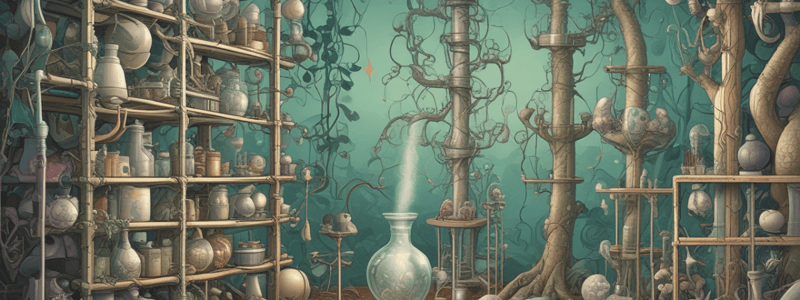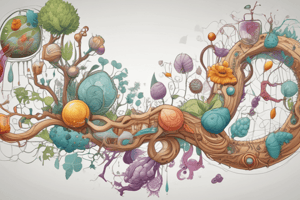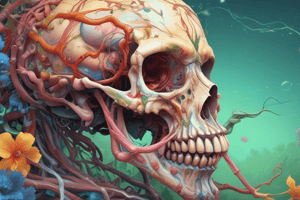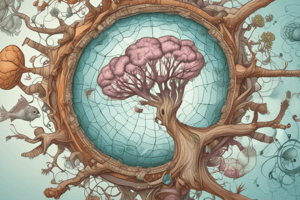Podcast
Questions and Answers
What is the study of the structure, function, growth, evolution, distribution, and taxonomy of all living things?
What is the study of the structure, function, growth, evolution, distribution, and taxonomy of all living things?
- Ecology
- Botany
- Zoology
- Biology (correct)
Which branch of biology studies the relationships between organisms and their environment?
Which branch of biology studies the relationships between organisms and their environment?
- Microbiology
- Biochemistry
- Genetics
- Ecology (correct)
What is the basic structural and functional unit of life?
What is the basic structural and functional unit of life?
- Cell (correct)
- Organ
- Molecule
- Tissue
Which level of organization consists of a group of similar cells that perform a specific function?
Which level of organization consists of a group of similar cells that perform a specific function?
What type of molecule provides energy and structure for cells?
What type of molecule provides energy and structure for cells?
Which biological molecule contains genetic information?
Which biological molecule contains genetic information?
What is the study of microorganisms such as bacteria, viruses, and fungi?
What is the study of microorganisms such as bacteria, viruses, and fungi?
What is the term for all ecosystems on Earth?
What is the term for all ecosystems on Earth?
Flashcards are hidden until you start studying
Study Notes
Definition of Biology
- Biology is the scientific study of life and living organisms.
- It explores the structure, function, growth, evolution, distribution, and taxonomy of all living things.
Branches of Biology
- Botany: study of plants and their interactions with the environment.
- Zoology: study of animals and their interactions with the environment.
- Microbiology: study of microorganisms such as bacteria, viruses, and fungi.
- Ecology: study of the relationships between organisms and their environment.
- Genetics: study of heredity, genes, and genetic variation.
- Biochemistry: study of the chemical processes that occur within living organisms.
- Molecular Biology: study of the structure, function, and interactions of biological molecules such as DNA, RNA, and proteins.
Levels of Organization
- Molecule: basic building blocks of life, such as DNA, proteins, and carbohydrates.
- Cell: the basic structural and functional unit of life.
- Tissue: group of similar cells that perform a specific function.
- Organ: structure composed of two or more types of tissues that perform a specific function.
- Organ System: group of organs that work together to perform a specific function.
- Organism: individual living thing, such as an animal, plant, or microorganism.
- Population: group of individuals of the same species living in a specific area.
- Community: group of different species living in a specific area.
- Ecosystem: community of living and non-living components interacting with each other.
- Biosphere: all ecosystems on Earth.
Biological Molecules
- Carbohydrates: provide energy and structure for cells.
- Proteins: perform a wide range of functions, including catalysis, transport, and structure.
- Nucleic Acids: DNA and RNA, which contain genetic information.
- Lipids: provide energy, structure, and function as hormones and vitamins.
Cell Biology
- Cell membrane: semi-permeable membrane that surrounds the cell.
- Cytoplasm: jelly-like substance inside the cell membrane.
- Nucleus: contains genetic material (DNA).
- Mitosis: process of cell division that results in two daughter cells.
- Meiosis: process of cell division that results in four daughter cells with half the number of chromosomes.
Evolution
- Theory of Evolution: explains how species change over time through natural selection, genetic drift, mutation, and gene flow.
- Natural Selection: process by which individuals with favorable traits are more likely to survive and reproduce.
- Speciation: process by which a new species emerges from an existing one.
Definition of Biology
- Scientific study of life and living organisms, exploring structure, function, growth, evolution, distribution, and taxonomy.
Branches of Biology
- Botany: studies plants and their environmental interactions.
- Zoology: studies animals and their environmental interactions.
- Microbiology: studies microorganisms like bacteria, viruses, and fungi.
- Ecology: studies relationships between organisms and their environment.
- Genetics: studies heredity, genes, and genetic variation.
- Biochemistry: studies chemical processes within living organisms.
- Molecular Biology: studies structure, function, and interactions of biological molecules like DNA, RNA, and proteins.
Levels of Organization
- Molecule: basic building blocks of life, such as DNA, proteins, and carbohydrates.
- Cell: basic structural and functional unit of life.
- Tissue: group of similar cells performing a specific function.
- Organ: composed of two or more tissue types, performing a specific function.
- Organ System: group of organs working together to perform a specific function.
- Organism: individual living thing, such as an animal, plant, or microorganism.
- Population: group of individuals of the same species living in a specific area.
- Community: group of different species living in a specific area.
- Ecosystem: community of living and non-living components interacting with each other.
- Biosphere: all ecosystems on Earth.
Biological Molecules
- Carbohydrates: provide energy and structure for cells.
- Proteins: perform functions like catalysis, transport, and structure.
- Nucleic Acids: contain genetic information as DNA and RNA.
- Lipids: provide energy, structure, and function as hormones and vitamins.
Cell Biology
- Cell membrane: semi-permeable membrane surrounding the cell.
- Cytoplasm: jelly-like substance inside the cell membrane.
- Nucleus: contains genetic material (DNA).
- Mitosis: results in two daughter cells through cell division.
- Meiosis: results in four daughter cells with half the number of chromosomes.
Evolution
- Theory of Evolution: explains species change over time through natural selection, genetic drift, mutation, and gene flow.
- Natural Selection: favors individuals with favorable traits to survive and reproduce.
- Speciation: process of a new species emerging from an existing one.
Studying That Suits You
Use AI to generate personalized quizzes and flashcards to suit your learning preferences.





